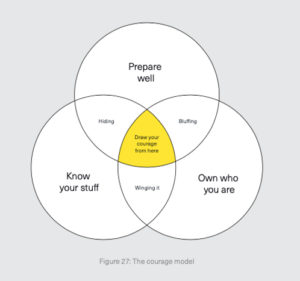How can we help?
Thank you for your enquiry, we will be in touch.
Oops! We could not locate your form.
Thank you for your enquiry, we will be in touch.
Oops! We could not locate your form.
Courage trumps confidence. Where confidence is a feeling (and I don’t know about you, but I haven’t yet mastered total control over my feelings!) courage is a decision – a choice we make about how we show up.
Put another way: if confidence is the light your audience sees shining from you, then courage is the energy that powers that light. It’s fierce and illuminating, and everyone has it. Yet some find it harder to access – and dial up – than others.
When it comes to presenting, you can find your courage with the following three amplifiers:
But I get it, that third one is a doozy that’s easier said than done. Most of us spend a lifetime working to get comfortable in our own skin. It’s worth the effort though, as the stronger you are in each of these three areas, the more courage you will have to draw from.
You can see the importance of each aspect when you consider what resides where just two of the amplifiers intersect and the other isn’t present.

If you know your stuff and own who you are but you’re not preparing well, then you’re winging it. If you prepare well and own who you are but don’t know your stuff, you’re bluffing. And if you prepare well and know your stuff, but don’t own who you are, you’re hiding.
And it’s hard to hide effectively when you’re the one up the front of the room talking. I think that’s why so many of us feel uncomfortable with the ‘all eyes on us’ aspect of presenting.
Owning who you are is always a work in progress, but there are some things that can help.
1. Record yourself and watch it back. Many people find this advice confronting. The problem comes when people start to judge themselves. They may encounter body image issues, or be surprised at how they perceive themselves on video. One person found she talked much more slowly than she realised; “I can almost see the wheels in my head turning!” she described. Seeing it all laid out on tape clues you into what you’re working with, which brings me to my next point…
2. Let go of what you can’t change and focus on what you can influence. There is plenty that you won’t be able to change about yourself, so you have to decide whether you can get comfortable with it. Focus on what you can influence – which might include wearing something that makes you feel awesome – then move on to ensure you are comfortable in your ideas.
3. Build an opposite narrative. If you are well-prepared and know your stuff, you know (and can reassure yourself) that you will be fine, even if you feel like you can’t do it. Think about other times you’ve been anxious and managed just fine and use those examples as evidence to apply here too.
4. Remember that you’re enough. In fact, you are more than enough. You don’t need to add anything. You don’t need to be performative or show up as you think others would. Strip all of the ‘shoulds’ away and let people see you.
Getting comfortable with yourself takes work; it’s not a switch you can flick. But people who are genuinely comfortable in themselves don’t tend to have a problem talking in front of an audience. They are OK with who they are and show up whole-heartedly and comfortable, with presence. And that’s what we all should be aspiring to.
Keep up to date with the latest tips and resources by joining our mailing list.